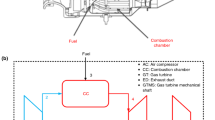Abstract
The burning of kerosene in jet turbines is investigated for two reference flights with a Boeing 747-400 and an Airbus A320-200, representing the typical Lufthansa planes for long and middle distance. The ecological evaluation is performed by Life Cycle Assessment (LCA). Formation of condensation trails, which is a specific environmental impact caused by air traffic, has to be considered in addition to established LCA impact categories. Based on the ecological assessment, an improvement assessment is performed. Environmental performance of diesel fuel during the combustion in car engines is analysed based on available publications. The relevant parameters for the environmental impact of the combustion of diesel (aromatics content, reduction of sulphur content, the reduction of the density and raising of the cetane number) are discussed with regard to improvements of the exhaust qualities of kerosene. A reduction of the aromatics content promises to improve the emission of soot which should be further investigated.
Similar content being viewed by others
References
CEPA (California Environmental Protection Agency): Release 96-16, Release 96-25, Release C-40–96 and Facts about Cleaner-Burning Gasoline (1996)
CONCAWE: Kerosines/Jet fuels. CONCAWE product dossier nℴ 94/106, Brussles, Belgium (April 1994)
DLR: Luftverkehr und Umwelt. Köln (November 1996)
Esso: Was muß noch geschehen? Esso-Report, S. 14–17 (Juni 1996)
Gabriel, R.: Ökologische Bewertung und Untersuchung des Verbesserungspotentials von Kerosin am Beispiel der Deutschen Lufthansa. Diploma Thesis at the Institute for Industrial Production (IIP), University of Karlsruhe (TH) (1997)
Gairing, M.; Naber, D.; Schäfer, A.; Lange, W.; Reglitzky, A.; Le Jeune, A.: Der Einfluß von Kraftstoffeigenschaften auf die Abgasemissionen moderner Dieselmotoren von Mercedes-Benz. In: MTZ Motortechnische Zeitschrift 55, Heft 1, Stuttgart (1994)
Geldermann, J.;Jahn, C.;Spengler, T.;Rentz, O.: Proposal for an Integrated Approach for the Assessment of “Best Available Techniques” BAT. Int. J. LCA4 (2) 94–106 (1999)
Goedkoop, M.: The Eco-indicator 95, Final Report. NOH report 9523, PRé Consultants, Amersfoot, the Netherlands (1996)
Haycock, R.F.; Thatcher, R.G.F.: Fuel additives and the environment. ATC-(Technical Committee of Petroleum Additive Manufacturers in Europe) Document 52 (1994)
Heijungs, R. et al.: Environmental Life Cycle Assessment of Products — Guide & Backgrounds. Centrum voor Milieukunde (CML), Leiden, Niederlande (1992)
ICAO: Engine Exhaust Emissions Data Bank. First Edition — 1995. ISO 14040: Umweltmanagement — Ökobilanz — Prinzipien und allgemeine Anforderungen. DIN EN ISO 14040 Deutsches Institut für Normung (DIN) (1997)
Owens, J.W.: LCA Impact Assessment Categories — Technical Feasibility and Accuracy. Int. J. LCA1 (3) 151–159 (1996)
POLINAT: Pollution from aircraft emissions in the north atlantic flight corridor. Environment Research Programme, Final Report, Oberpfaffenhofen (1996)
Rentz, O.;Geldermann, J.;Jahn, C.;Spengler, T.: Proposal for an integrated approach for the assessment of cross-media aspects relevant for the determination of ‘Best Available Techniques’ BAT in the European Union — Project Report on behalf of the UBA (Berlin). Deutsch-Französisches Institut für Umweltforschung (DFIU), Karlsruhe (January 1998)
Roj, A.; Karlsson, K.: High Quality Diesel Fuel Reduces Emissions. In: Fuel Reformulation, S. 46–52 (September/October 1995)
Schumann, U.: Emissionen des Luftverkehrs im Reiseflug und dadurch bedingte Änderungen in der Atmosphäre, Globale Auswirkungen der Emissionen auf Ozon und Klima. Seminar Nr. 19606 “Luftreinhaltung im Flugverkehr”, Weßling (1996)
SETAC: Guidelines for Life-Cycle Assessment: A ‘Code of Practice’. SETAC, from the workshop held in Sesimbra, Portugal (31.3–3.4. 1993)
Singhofen, A. et al.: Life Cycle Inventory Data: Development of a Common Format. In: Int. J. LCA1 (3) 171–178 (1996)
UBA-Texte 52/95 (Schmiß, S.; Oels, H.-J.; Tiedemann, A.): Ökobilanz für Getränkeverpackungen. Berlin (1995) (English version: UBA-Texte 19/96: Life-cycle assessment for drinks packaging systems.)
Author information
Authors and Affiliations
Corresponding author
Rights and permissions
About this article
Cite this article
Geldermann, J., Gabriel, R. & Rentz, O. Ecological assessment of the environmental impacts of the kerosene burning in jet turbines and its improvement assessment. Environ. Sci. & Pollut. Res. 6, 115–121 (1999). https://doi.org/10.1007/BF02987564
Received:
Accepted:
Issue Date:
DOI: https://doi.org/10.1007/BF02987564




